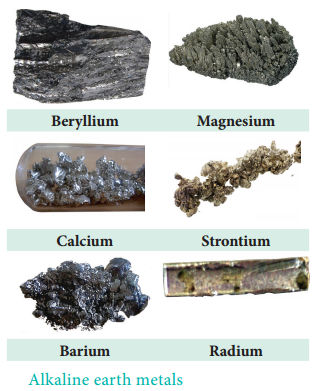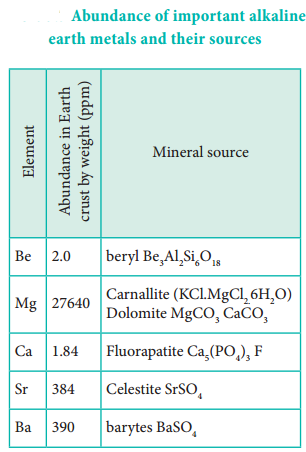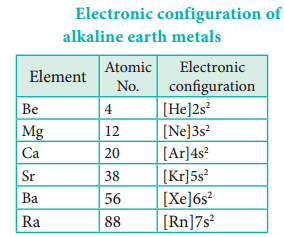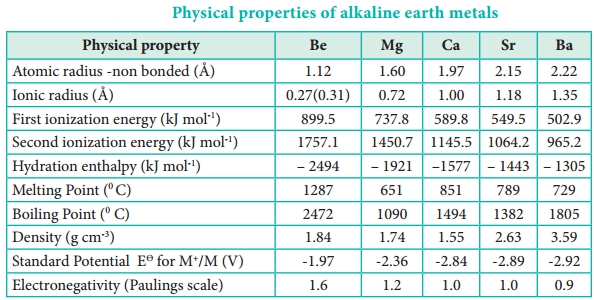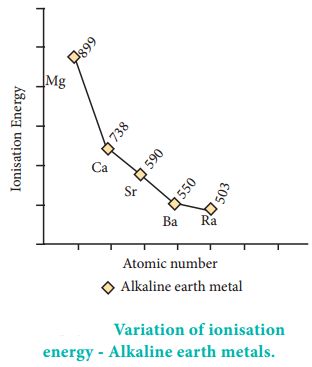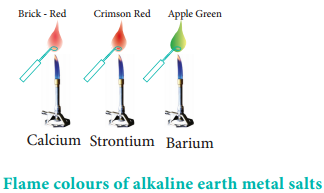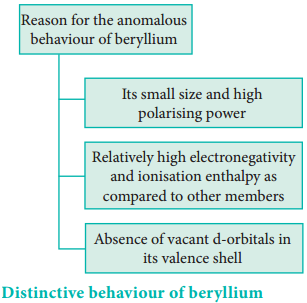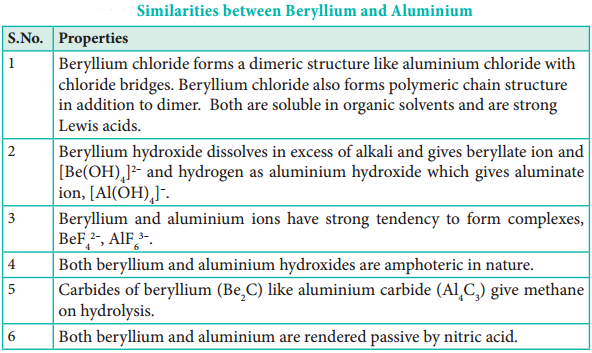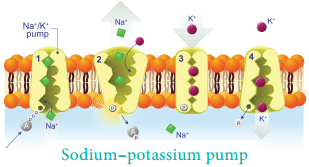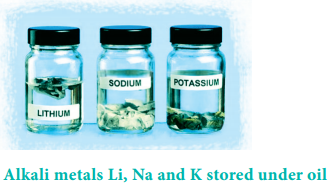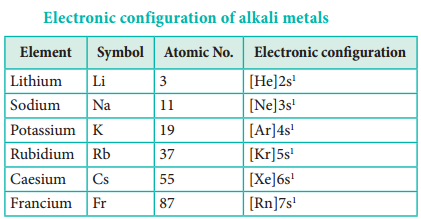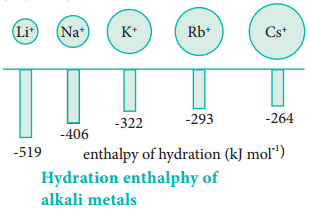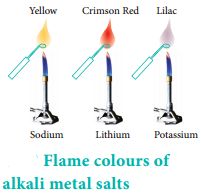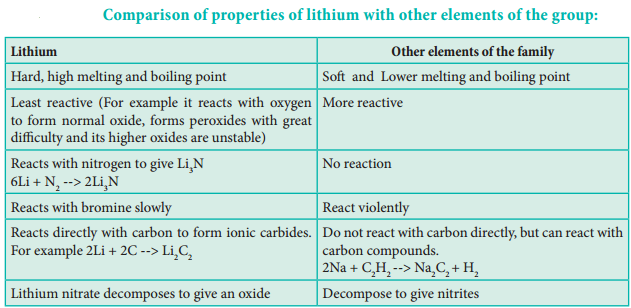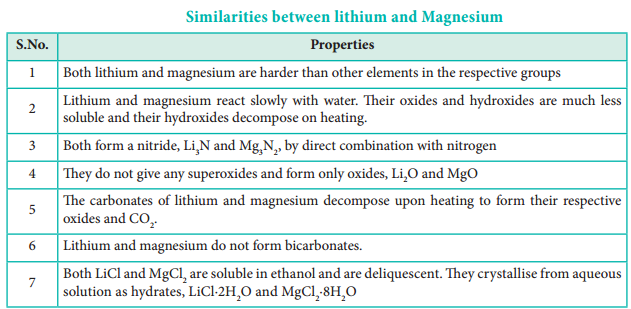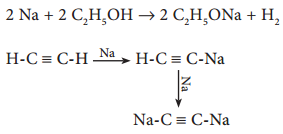Find free online Chemistry Topics covering a broad range of concepts from research institutes around the world.
General Characteristics of the Compounds of the Alkali Earth Metals
The dipositive oxidation state (M2+) is the predominant valence of group 2 elements. The alkaline earth metals form compounds which are predominantly ionic. However, they are less ionic than the corresponding compounds of alkali metals. This is due to increased nuclear charge and smaller size. The general characteristics of some of the compounds of alkaline earth metals are described below.
(a) Oxides:
Generally alkaline earth metals form monoxides and peroxides.
Monoxides
Monoxides are obtained by heating the metals in oxygen. BeO and MgO are almost insoluble in water. On the other hand, oxides of other elements form hydroxides. BeO is amphoteric; MgO is weakly basic while CaO, SrO and BaO are strongly basic.
BeO oxide is covalent due to the small size of Be2+ ion, while other oxides are ionic in nature.
Peroxides
Except beryllium, all the remaining metals form peroxides. It is prepared by heating monoxides with oxygen at high temperature.
2 BaO + O2 → 2 BaO2
(b) Hydroxides:
All the oxides except BeO are basic in nature and react with water to form sparingly soluble hydroxides.
MO + H2O → M(OH)2
The solubility, thermal stability and the basic character of the hydroxides increase down the group. The alkaline earth metal hydroxides are, however, less basic and less stable than alkali metal hydroxides. Beryllium hydroxide is amphoteric in nature as it reacts with both acid and alkali.
Be(OH)2 + 2 NaOH → Na2BeO2 + 2H2O
Be(OH)2 + 2HCl → BeCl2 + 2H2O
(c) Halides:
Alkaline earth metals form halides with general formula MX2. They can be prepared by heating metals with halogens on heating.
M +X2 → MX2
Beryllium halides are covalent on account of smaller size of Be2+. Beryllium halides are hygroscopic, fume in moist air and soluble in organic solvents. Beryllium chloride has a chain structure in the solid state as shown in figure 5.9 (structure-a). In the vapour phase BeCl2 tends to form a chloro-bridged dimer (structure-c) which dissociates into the linear monomer at high temperatures of the order of 1200 K. (structure-b).
Except beryllium halides, all the other halides of alkaline earth metals are ionic in nature. Chloride and fluorides of the other metals are ionic solids. These are good conductors of electricity in fused state and inaqueous solutions. The tendency to form halide hydrates gradually decreases (for example, MgCl2.8H2O, CaCl2.6H2O, SrCl2.6H2O and BaCl2.2H2O) down the group.

Salts of Oxo Acids
The alkaline earth metals form salts of oxo acids. Some of these are given below:
Carbonates:
All the carbonates decompose on heating to give carbon dioxide and the oxide.
![]()
- The solubility of carbonates in water decreases down the group.
- The thermal stability increases down the group with increasing cationic size.
Decomposition temperature of alkaline metal carbonates and sulphates
Element | Decomposition temp for carbonates (in °C) | Decomposition |
| Be | 25 | 500 |
| Mg | 540 | 895 |
| Ca | 900 | 1149 |
| Sr | 1290 | 1374 |
| Ba | 1360 | – |
The sulphates of the alkaline earth metals are all white solids and stable to heat. BeSO4, and MgSO4 are
readily soluble in water; the solubility decreases from CaSO4 to BaSO4. The greater hydration enthalpies of
Be2+ and Mg2+ ions overcome the lattice enthalpy factor and therefore their sulphates are soluble in water.
Nitrates:
The nitrates are made by dissolution of the carbonates in dilute nitric acid. Magnesium nitrate crystallises with six molecules of water, whereas barium nitrate crystallises as the anhydrous salt. This again shows a decreasing tendency to form hydrates with increasing size. All of them decompose on heating to give the oxide.
Important Compounds of Calcium
Quick lime, CaO
Preparation
It is produced on a commercial scale by heating limestone in a lime kiln in the temperature range 1070-1270K.
CaCO3 ⇄ CaO + CO2
The reaction being reversible, carbon dioxide is removed as soon as it is produced to enable the reaction to proceed to completion.
Properties
Calcium oxide is a white amorphous solid. It has a melting point of 2870 K.
(i) It absorbs moisture and carbon dioxide on exposure to atmosphere.
CaO + H2O → Ca(OH)2
CaO + CO2 → CaCO3
(ii) The addition of limited amount of water breaks the lump of lime. This process is called slaking of lime and the product is slaked lime.
CaO + H2O → Ca(OH)2
(iii) The mixture of Quick lime(CaO) and sodium hydroxide is called soda lime.
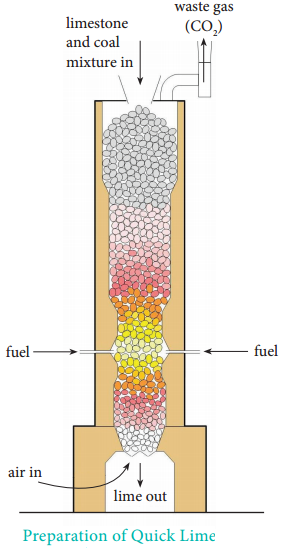
(iv) It combines with acidic oxides such as SiO2 and P4O10 to form CaSiO3 and Ca3(PO4)2, respectively.
CaO + SiO2 → CaSiO3
6CaO + P4O10 → 2Ca3(PO4)2
Uses
Calcium oxide is used
- To manufacture cement, mortar and glass.
- In the manufacture of sodium carbonate and slaked lime.
- In the purification of sugar.
- As a drying agent.
Calcium Hydroxide
Preparation
Calcium hydroxide is prepared by adding water to quick lime, CaO.
Properties
It is a white powder. It is sparingly soluble in water. The aqueous solution is known as lime water and a suspension of slaked lime in water is known as milk of lime.
When carbon dioxide is passed through lime water, it turns milky due to the formation of calcium carbonate.
Ca(OH)2 + CO2 → CaCO3 + H2O
On passing excess of carbon dioxide, the precipitate dissolves to form calcium hydrogen carbonate.
CaCO3 + CO2 + H2O → Ca(HCO3)2
Milk of lime reacts with chlorine to form hypochlorite, a constituent of bleaching powder.
2Ca (OH)2 + 2Cl2 →
CaCl2 + Ca(OCl2) + 2H2O
Uses:
Calcium hydroxide is used
- In the preparation of mortar, a building material.
- In white wash due to its disinfectant nature.
- In glass making, in tanning industry, in the preparation of bleaching powder and for the purification of sugar.
Gypsum (CaSO4.2H2O)
Gypsum beds were formed due to the evaporation of water from the massive prehistoric sea basins. When water evaporates, the minerals present in it become concentrated, and crystallise.
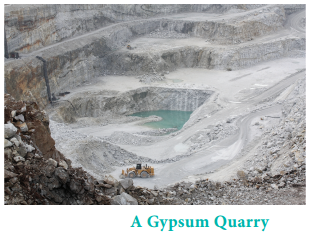
Properties of Gypsum
Gypsum is a soft mineral, which is moderately soluble in water. The solubility of this mineral in water is affected by temperature. Unlike other salts, gypsum becomes less soluble in water as the temperature increases. This is known as retrograde solubility, which is a distinguishing characteristic of gypsum.
Gypsum is usually white, colorless, or gray in color. But sometimes, it can also be found in the shades of pink, yellow, brown, and light green, mainly due to the presence of impurities.
Gypsum crystals are sometimes found to occur in a form that resembles the petals of a flower. This type of formation is referred to as ‘desert rose’, as they mostly occur in arid areas or desert terrains.
Gypsum is known to have low thermal conductivity, which is the reason why it is used in making drywalls or wallboards. Gypsum is also known as a natural insulator.
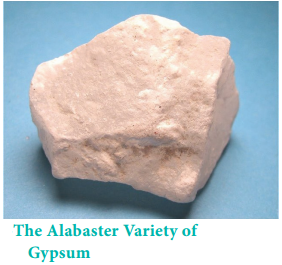
Alabaster is a variety of gypsum, that is highly valued as an ornamental stone. It has been used by the sculptors for centuries. Alabaster is granular and opaque.
Gypsum has hardness between 1.5 to 2 on Moh’s Hardness Scale. Its specific gravity is 2.3 to 2.4.
Uses of Gypsum
1. The alabaster variety of gypsum was used in ancient Egypt and Mesopotamia by the sculptors. The ancient Egyptians knew how to turn gypsum into plaster of Paris about 5,000 years ago. Today, gypsum has found a wide range of uses and applications in human society, some of which are enlisted below.
2. Gypsum is used in making drywalls or plaster boards. Plaster boards are used as the finish for walls and ceilings, and for partitions.
3. Another important use of gypsum is the production of plaster of Paris. Gypsum is heated to about 300 degree Fahrenheit to produce plaster of Paris, which is also known as gypsum plaster. It is mainly used as a sculpting material.
4. Gypsum is used in making surgical and orthopedic casts, such as surgical splints and casting moulds.
5. Gypsum plays an important role in agriculture as a soil additive, conditioner, and fertilizer. It helps loosen up compact or clay soil, and provides calcium and sulphur, which are essential for the healthy growth of a plant. It can also be used for removing sodium ion from soils having excess salinity.
6. Gypsum is used in toothpastes, shampoos, and hair products, mainly due to its binding and thickening properties.
7. Gypsum is a component of Portland cement, where it acts as a hardening retarder to control the speed at which concrete sets.
8. To sum up, gypsum is one of the most abundant minerals that have endless uses and applications. Mining of gypsum is simple and easy, as the mineral occurs in large thick beds near the Earth’s surface. However, large-scale mining of gypsum involves considerable damage to the environment. Gypsum can also be recycled, but not much importance has been given to recycle this mineral due to its abundance.
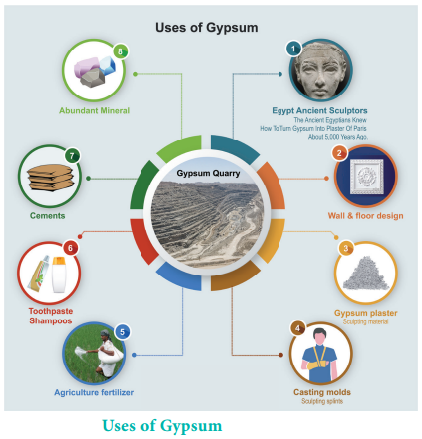
Plaster of Paris
Calcium Sulphate Hemihydrate:
CaSO4·½ H2O (Plaster of Paris)
It is a hemihydrate of calcium sulphate. It is obtained when gypsum, CaSO4.2H2O is heated to 393 K.
2CaSO4.2H2O(s) → 2 CaSO4. ½ H2O + 3H2O
Above 393 K, no water of crystallisation is left and anhydrous calcium sulphate, CaSO4 is formed. This is known as ‘dead burnt plaster’.
It has a remarkable property of setting with water. On mixing with an adequate quantity of water it forms a plastic mass that gets into a hard solid in 5 to 15 minutes.
Uses:
Plaster of Paris is used as/in,
- The building industry as well as plasters.
- For immobilising the affected part of organ where there is a bone fracture or sprain.
- Employed in dentistry, in ornamental work and for making casts of statues and busts.

